Trach ties
Tracheostomy Page
A tracheostomy is a surgical opening into the trachea, or windpipe, to facilitate breathing. A tracheostomy itself is not a disability. But the disease process that necessitates the procedure to be done can be.

There are many reasons that someone may have a tracheostomy. Most commonly it is thought of as someone that has had laryngeal cancer or throat cancer. There are many that have them for that reason, but it is not the exclusive reason for a tracheostomy.

There are children with tracheostomies, for tracheomalacia (a weakening of the windpipe), Pierre-Robbins Syndrome (where the upper airway is small due to the syndrome), vocal cord paralysis either from birth trauma or intubation (breathing tube) shortly after birth, growths in the upper airway, or any other disease which causes upper airway obstruction.

There are more adults with tracheostomies also. They are not the "last resort" that they used to be considered years ago. If conservative measures fail to alleviate sleep apnea, a tracheostomy will be placed so that the sleep apnea sufferer can sleep with an unobstructed airway. In most sleep apnea cases they "cap" their tracheostomy tube during the day and uncap it at night during sleep. In these cases you may not even know that a person has a tracheostomy if you were to see them at work during the day.
They are still used for cancer of the larynx or upper airway. Medical and surgical advances have made it so that not all people with laryngeal cancer need a permanent tracheostomy. They are able to remove just the cancerous tissue and preserve some of the larynx, and the patient only needs a tracheostomy on a temporary basis. I have a tracheostomy because I have severe laryngeal dystonia, meaning my vocal cords are closed due to spasms.

Those who need chronic ventilator support, for whatever reason, will have a tracheostomy also. This makes it easier for the person to function as best they can, as well as make it easier to care for them. Long term intubation by oral or nasal route is not carried out as often making long term acute care less necessary. Many long-term ventilator dependent persons are capable of being at home with some assistance, rather than in a chronic or acute care facility.

People with tracheostomies are generally the same as everyone else, just that their airway takes a detour. If they have a normal immune system they are no more susceptible to colds than anyone else. There is always some bacteria or viruses that "colonize" or live at a tracheostomy site. Just like the ones that live on everyone's hands or skin. Most go through life without any infections at all. Some of us with tracheostomies just have to be aware of a change or increase in secretions or fever which is an indication that we have gotten an infection.

Trach tubes
Trach tubes come in all sizes from super small for infants to larger ones for adults. They also have various configurations. The two main materials used in making trach tubes are plastic and metal, usually silver.
Most trach tubes fall into the "Jackson" type. They are the type used by adults, with an outer cannula and inner cannula. Jackson tubes can be either metal or plastic. Most refer to Jackson tubes as the metal when referring to them recently.

Others are referred to more by their manufacturers. Shiley is a form of Jackson for adults, and a single cannula for children and infants.


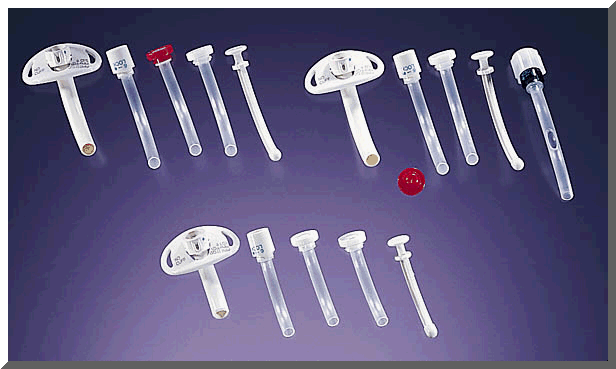 Cuffless Trach tubes
Cuffless Trach tubes
click for larger image
images used courtesy of Bivona and Mallinkrodt/Nellcor
For those on ventilators or who need the added airway protection there are trach tubes that have a "cuff", a balloon type device that prevents air or other material from getting past the trach tube. The cuff is usually inflated with air. If the "pilot", the indicator that attaches to the cuff, is soft and squishy, then there is air in the cuff.
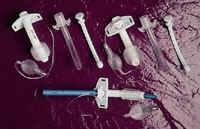
Cuffed Trach tube
images used courtesy of Mallinkrodt/Nellcor
There are tubes for those who need to speak when mechanically ventilated, that have an opening on the back curve of the trach tube both inner and outer cannulas. These are called "Fenestrated." Persons who are not mechanically ventilated who have trachs are able to talk with a cuffless trach tube as well. Some physicians prefer cuffless over fenestrated for spontaneously breathing patients stating that the fenestration causes irritation or formation of granuloma in the trachea. The opening for the fenestration is not smooth and becomes an irritant to the tracheal lining, causing granuloma formation. A non-fenestrated tube is smooth and not irritating to the fragile tracheal lining. A cuffless, non-fenestrated trach tube does allow enough air to bypass the trach tube to allow speech.
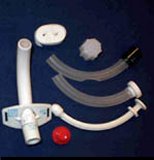 Fenestrated Trach Tube
Fenestrated Trach Tube
click here for larger image
images used courtesy of Mallinkrodt/Nellcor
The Bivona trach tube is similar to other Jackson tubes. It usually has a single cannula, no removable inner cannula. The one aspect of Bivona over other Jackson tubes is that it is softer and more flexible.
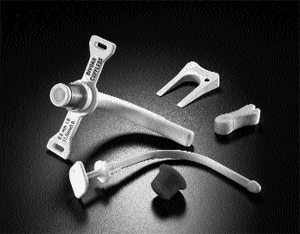
Bivona Trach Tube
images used courtesy of Bivona
The Tracoe Comfort and Tracoe Twist are made by Boston Medical. They are made from medical silicone and more 'forgiving' than the hard plastic shiley tube.
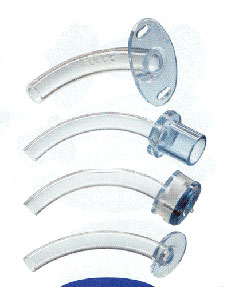
click here for larger image
image used courtesy of BostonMedical
One other form of trachealstoma device to keep the stoma open is called a Hood Stoma System, "Stoma button" or Montgomery Tracheostoma Tube. They are different from other trach tubes in that they do not extend down into the trachea. They are used to keep the stoma open exclusively. These type of tubes do not require trach ties to secure them. They have a "skirt", or flange, on the inner end that is inserted into the stoma that prevents it from being coughed out. They are hollow to facilitate breathing or solid to act as a plug, while still maintaining the stoma.
Hood Stoma Systems
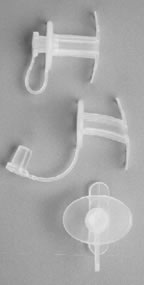
click here for larger image
images used courtesy of Hood Labs




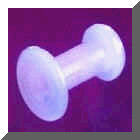
Stoma Buttons
images used courtesy of Portex
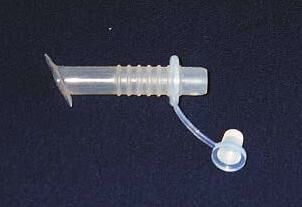
Montgomery Button
image courtesy of Boston Medical
You can find more information on tracheostomies at the following links:
Links are listed in no particular order. Any products are neither endorsed or encouraged by Trach-ties and are solely for information purposes.
Trach Links
Aaron's Tracheostomy Page
Mike's Tracheostomy Page
Dave's Trach Stuff
Tracheotomy Info Group
Portex Trach tubes and related equipment
Nellcor-Mallinkrodt - makers of Shiley Trach tubes.
Tracoe Tracheostomy Supplies
Bivona Trach tubes Webpage
Boston Medical Supplies- Tracheostomy and Laryngectomy related equipment
Disclaimer; In no way are these web pages or links intended to replace care by a qualified medical professional. They are here for information only. If you feel you fit any of the symptoms listed in any of these links you should seek care from a qualified medical professional.
Trachties



















